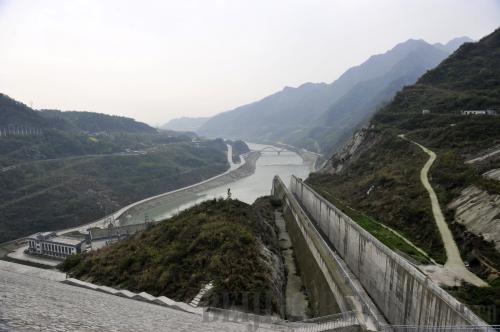|
 |
|
BACK ON THE JOB: Water flows out of the Zipingpu Reservoir in a channel. Consolidation of the earthquake-damaged reservoir is ongoing (SHI GANG) |
Drinking water
The Wenchuan earthquake also damaged drinking water sources and water pipes. After the earthquake, the Sichuan Provincial Water Resources Department has activated a water supply emergency plan. Local governments delivered water to people in earthquake-stricken areas with vehicles and swiftly repaired pipes.
The department made securing drinking water supplies a priority and incorporated it into the overall post-quake reconstruction plan.
Ma Qianguo, head of Luobozhai Village in Wenchuan County, said villagers used to fetch water from tall mountains, yet only a year after the earthquake in 2008, they were given access to tap water. But Luobozhai Village sat on an earthquake fault. Due to aftershocks of the Wenchuan earthquake, water pipes have been broken and repaired more than 30 times.
Now all 6.68 million people in earth-stricken areas are supplied safe drinking water.
Yet there are still challenges. Zhu said, due to unstable geological conditions after the earthquake, water supplies in earthquake-stricken areas might still be disrupted in future.
Disaster prevention
"In the past three years, reservoirs damaged by the earthquake and barrier lakes have worried the Sichuan Provincial Water Sources Department. If anything goes wrong, it will cause great fatalities and property loss," Zhu said.
Immediately after the earthquake, the department activated an emergency plan to deal with these damaged reservoirs and barrier lakes. Measures were taken to assess risks and remove hazards. One contingency measure taken was to lower the water stock in damaged reservoirs to a safe level.
Eleven barrier lakes were created along the rivers in Deyang City. The hydrology group of Deyang's disaster relief headquarters organized four on-site surveys on these barrier lakes. Survey teams carefully studied the lakes' shape and structure, as well as the water level and runoff volume. They assessed the risks and devised plans to remove hazards.
So far, almost all hazards in 10 of the 11 lakes had been removed, said Li Ping, head of the Engineering Division of the Deyang Municipal Water Resources Department.
After the Wenchuan earthquake, Sichuan conducted drills to evacuate residents and their properties, simulating the collapse of barrier lakes and damaged reservoirs.
Zhu said, "We conducted each rehearsal around different reservoirs and in different areas, and we mobilized local residents to participate. In additional to drills organized by the provincial government, we also require every prefecture and city with damaged reservoirs to organize drills, so residents will know where to run to and how to get there in case of danger."
A report on the post-earthquake reconstruction of hydro infrastructure released by the Sichuan Provincial Water Resources Department says consolidation on all earthquake-damaged reservoirs has been completed, except on part of the Zipingpu Reservoir. All these reservoirs were safe in the past two flood seasons, and they are effective in supplying water and preventing floods. None of the barrier lakes has collapsed. Projects to drain the lakes are also finished except for the one in Tangjiashan Barrier Lake, which is expected to be completed before this year's flood season.
New projects
When the post-quake hydro infrastructure reconstruction is completed, Sichuan plans to build more irrigation systems. In October 2009, the province set a new goal to build another Dujiangyan Irrigation System, and wrote it into its development plan for 2011-15.
The Dujiangyan Irrigation System supplies water to about 680,000 hectares of farmland in Sichuan. The goal to build another Dujiangyan Irrigation System meant to construct a series of irrigation facilities by the year 2016 to irrigate about 713,000 hectares of farmland, Zhu said. That is equivalent to doubling the irrigation capacity of Dujiangyan Irrigation System.
From 2016 to 2020, an additional 666,000 hectares of farmland would be covered by the irrigation system, Zhu said, adding building more irrigation systems is also part of efforts to implement the national food security strategy. | 